Walbank F.W., Astin A.E., Frederiksen M.W., Ogilvie R.M. The Cambridge Ancient History, Volume 7, Part 1: The Hellenistic World
Подождите немного. Документ загружается.

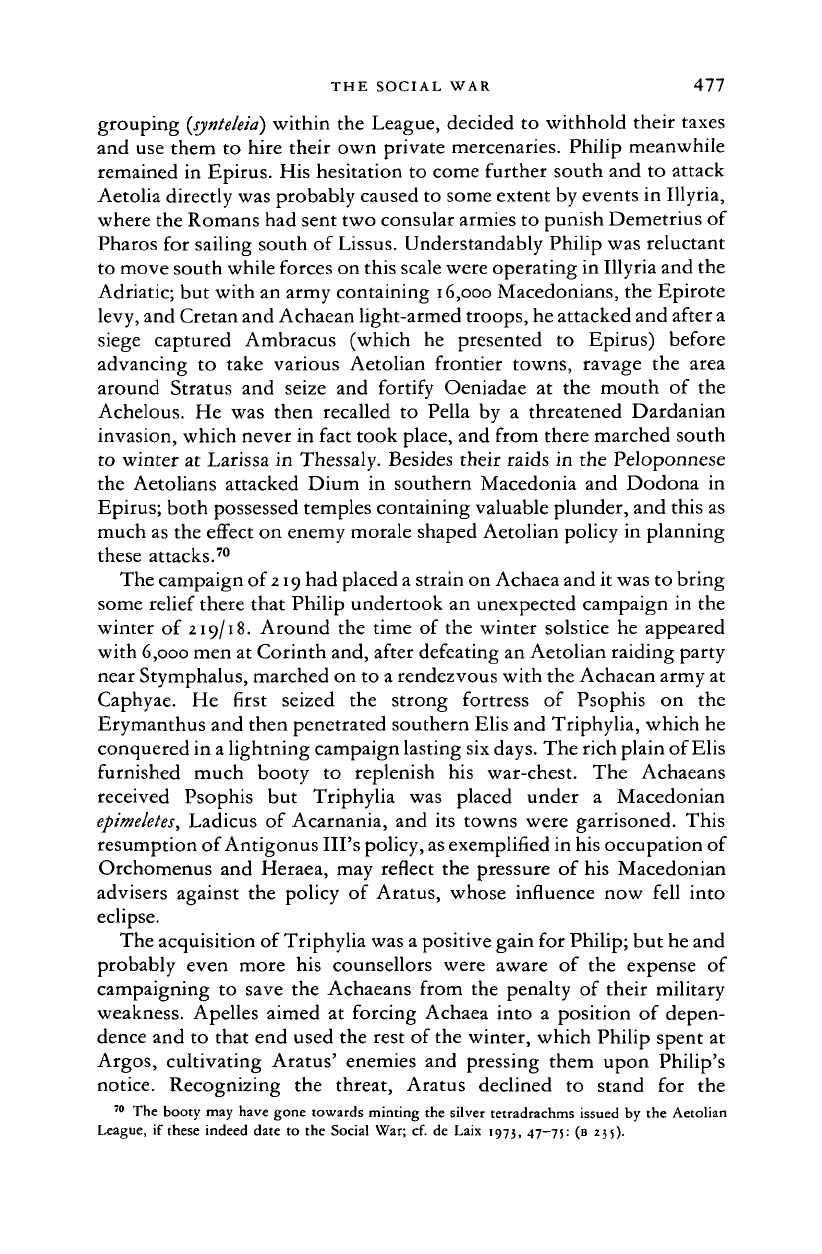
THE
SOCIAL
WAR 477
grouping
(synteleia)
within the League, decided to withhold their taxes
and use them to hire their own private mercenaries. Philip meanwhile
remained in Epirus. His hesitation to come further south and to attack
Aetolia directly was probably caused to some extent by events in Illyria,
where the Romans had sent two consular armies to punish Demetrius of
Pharos for sailing south of
Lissus.
Understandably Philip was reluctant
to move south while forces on this scale were operating in Illyria and the
Adriatic; but with an army containing 16,000 Macedonians, the Epirote
levy, and Cretan and Achaean light-armed troops, he attacked and after
a
siege captured Ambracus (which he presented to Epirus) before
advancing to take various Aetolian frontier towns, ravage the area
around Stratus and seize and fortify Oeniadae at the mouth of the
Achelous. He was then recalled to Pella by a threatened Dardanian
invasion, which never in fact took place, and from there marched south
to winter at Larissa in Thessaly. Besides their raids in the Peloponnese
the Aetolians attacked Dium in southern Macedonia and Dodona in
Epirus; both possessed temples containing valuable plunder, and this as
much as the effect on enemy morale shaped Aetolian policy in planning
these attacks.
70
The campaign of
219
had placed
a
strain on Achaea and it was to bring
some relief there that Philip undertook an unexpected campaign in the
winter of 219/18. Around the time of the winter solstice he appeared
with 6,000 men at Corinth and, after defeating an Aetolian raiding party
near Stymphalus, marched on to a rendezvous with the Achaean army at
Caphyae. He first seized the strong fortress of Psophis on the
Erymanthus and then penetrated southern Elis and Triphylia, which he
conquered in
a
lightning campaign lasting six
days.
The rich plain of Elis
furnished much booty to replenish his war-chest. The Achaeans
received Psophis but Triphylia was placed under a Macedonian
epimeletes,
Ladicus of Acarnania, and its towns were garrisoned. This
resumption of Antigonus Ill's policy,
as
exemplified in his occupation of
Orchomenus and Heraea, may reflect the pressure of his Macedonian
advisers against the policy of Aratus, whose influence now fell into
eclipse.
The acquisition of Triphylia was a positive gain for Philip; but he and
probably even more his counsellors were aware of the expense of
campaigning to save the Achaeans from the penalty of their military
weakness. Apelles aimed at forcing Achaea into a position of depen-
dence and to that end used the rest of the winter, which Philip spent at
Argos, cultivating Aratus' enemies and pressing them upon Philip's
notice. Recognizing the threat, Aratus declined to stand for the
70
The booty may have gone towards minting the silver tetradrachms issued by the Aetolian
League, if these indeed date to the Social War; cf. de Laix 1973, 47-75: (B 235).
Cambridge Histories Online © Cambridge University Press, 2008
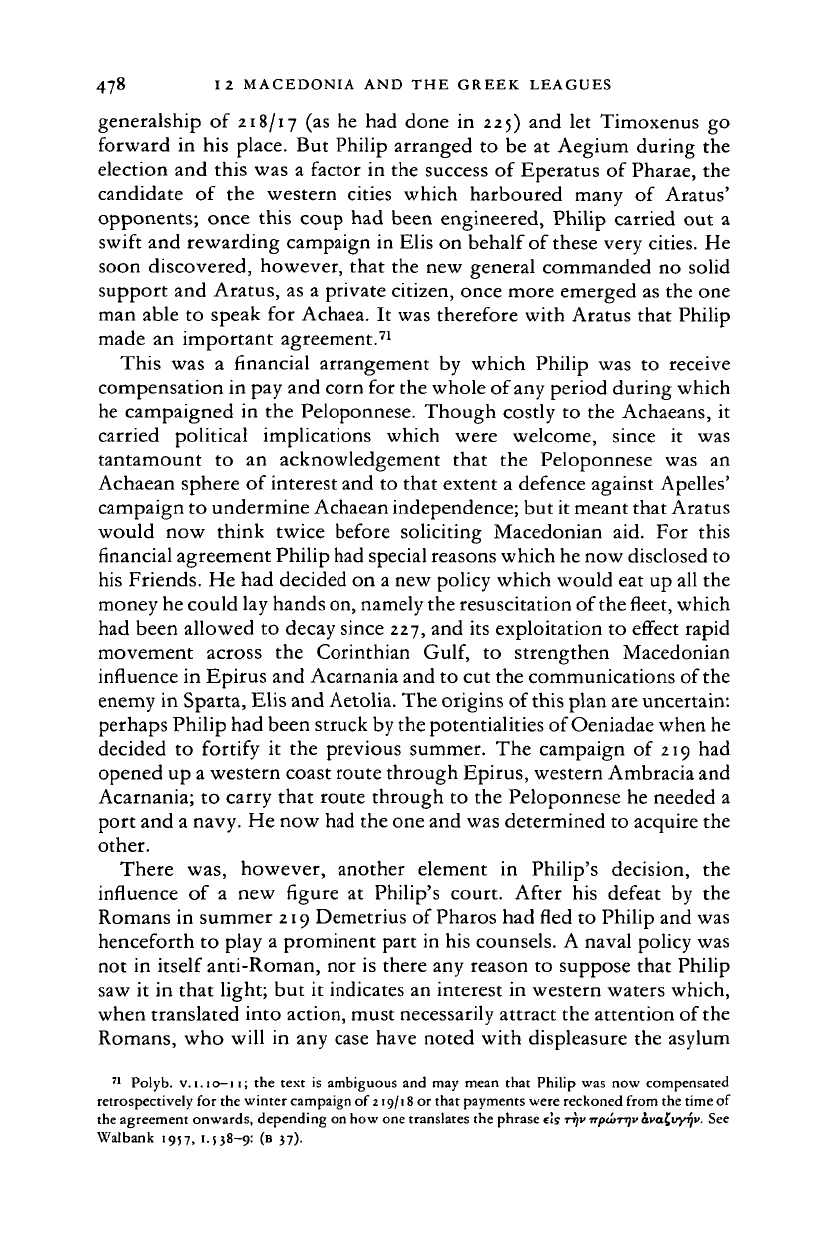
478 12 MACEDONIA AND THE GREEK LEAGUES
generalship
of
218/17
(as he had
done
in
225)
and let
Timoxenus
go
forward
in his
place.
But
Philip arranged
to be at
Aegium during
the
election
and
this was
a
factor
in
the success
of
Eperatus
of
Pharae,
the
candidate
of the
western cities which harboured many
of
Aratus'
opponents; once this coup
had
been engineered, Philip carried
out a
swift and rewarding campaign
in
Elis
on
behalf
of
these very cities.
He
soon discovered, however, that the new general commanded
no
solid
support and Aratus, as
a
private citizen, once more emerged as the one
man able
to
speak
for
Achaea.
It
was therefore with Aratus that Philip
made
an
important agreement.
71
This
was a
financial arrangement
by
which Philip
was to
receive
compensation in pay and corn
for
the whole of any period during which
he campaigned
in the
Peloponnese. Though costly
to
the Achaeans,
it
carried political implications which were welcome, since
it was
tantamount
to an
acknowledgement that
the
Peloponnese
was an
Achaean sphere
of
interest and
to
that extent
a
defence against Apelles'
campaign to undermine Achaean independence; but it meant that Aratus
would
now
think twice before soliciting Macedonian
aid. For
this
financial agreement Philip had special reasons which he now disclosed to
his Friends. He had decided
on
a new policy which would eat up all the
money he could lay hands on, namely the resuscitation of the fleet, which
had been allowed
to
decay since 227, and its exploitation
to
effect rapid
movement across
the
Corinthian
Gulf,
to
strengthen Macedonian
influence
in
Epirus and Acarnania and to cut the communications of the
enemy in Sparta, Elis and Aetolia. The origins of this plan are uncertain:
perhaps Philip had been struck by the potentialities of Oeniadae when he
decided
to
fortify
it the
previous summer.
The
campaign
of
219
had
opened up a western coast route through Epirus, western Ambracia and
Acarnania;
to
carry that route through
to
the Peloponnese he needed
a
port and a navy. He now had the one and was determined to acquire the
other.
There
was,
however, another element
in
Philip's decision,
the
influence
of a new
figure
at
Philip's court. After
his
defeat
by the
Romans
in
summer 219 Demetrius
of
Pharos had fled
to
Philip and was
henceforth
to
play
a
prominent part
in
his counsels.
A
naval policy was
not
in
itself anti-Roman, nor
is
there any reason
to
suppose that Philip
saw
it in
that light;
but it
indicates
an
interest
in
western waters which,
when translated into action, must necessarily attract the attention of the
Romans, who will
in any
case have noted with displeasure
the
asylum
71
Polyb.
v.i.10—
11;
the
text
is
ambiguous
and may
mean that Philip
was now
compensated
retrospectively for the winter campaign
of
219/18
or
that payments were reckoned from the time of
the agreement onwards, depending on how one translates the phrase t!s
-njv Trpclrrqv
awifuyiji'. See
Walbank 1957,
1.J38-9:
(B
37).
Cambridge Histories Online © Cambridge University Press, 2008
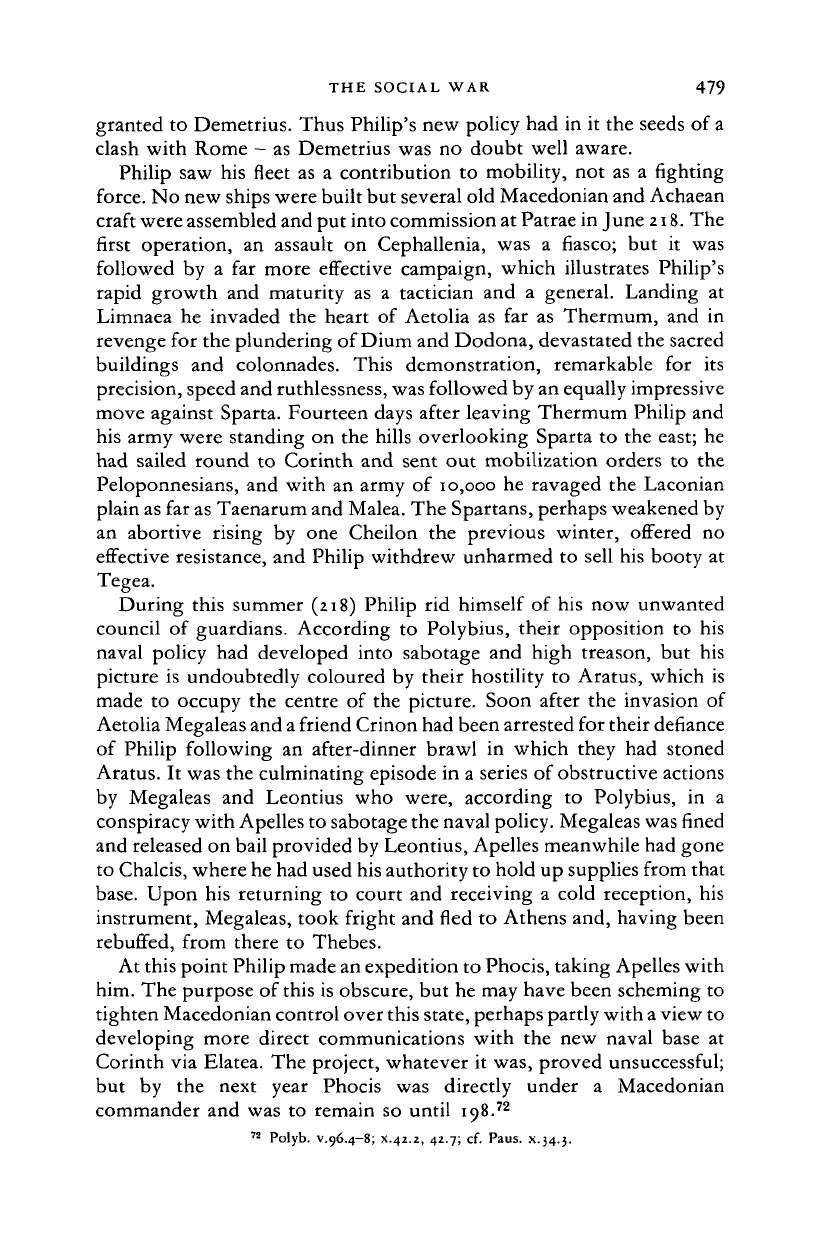
THE SOCIAL WAR 479
granted to Demetrius. Thus Philip's new policy had in it the seeds of a
clash with Rome
—
as Demetrius was no doubt well aware.
Philip saw his fleet as a contribution to mobility, not as a fighting
force. No new ships were built but several old Macedonian and Achaean
craft were assembled and put into commission at Patrae in June
218.
The
first operation, an assault on Cephallenia, was a fiasco; but it was
followed by a far more effective campaign, which illustrates Philip's
rapid growth and maturity as a tactician and a general. Landing at
Limnaea he invaded the heart of Aetolia as far as Thermum, and in
revenge for the plundering of Dium and Dodona, devastated the sacred
buildings and colonnades. This demonstration, remarkable for its
precision, speed and ruthlessness, was followed by an equally impressive
move against Sparta. Fourteen days after leaving Thermum Philip and
his army were standing on the hills overlooking Sparta to the east; he
had sailed round to Corinth and sent out mobilization orders to the
Peloponnesians, and with an army of 10,000 he ravaged the Laconian
plain as far as Taenarum and Malea. The Spartans, perhaps weakened by
an abortive rising by one Cheilon the previous winter, offered no
effective resistance, and Philip withdrew unharmed to sell his booty at
Tegea.
During this summer (218) Philip rid himself of his now unwanted
council of guardians. According to Polybius, their opposition to his
naval policy had developed into sabotage and high treason, but his
picture is undoubtedly coloured by their hostility to Aratus, which is
made to occupy the centre of the picture. Soon after the invasion of
Aetolia Megaleas and
a
friend Crinon had been arrested for their defiance
of Philip following an after-dinner brawl in which they had stoned
Aratus. It was the culminating episode in a series of obstructive actions
by Megaleas and Leontius who were, according to Polybius, in a
conspiracy with Apelles to sabotage the naval policy. Megaleas was fined
and released on bail provided by Leontius, Apelles meanwhile had gone
to Chalcis, where he had used his authority to hold up supplies from that
base.
Upon his returning to court and receiving a cold reception, his
instrument, Megaleas, took fright and fled to Athens and, having been
rebuffed, from there to Thebes.
At this point Philip made an expedition to Phocis, taking Apelles with
him. The purpose of this is obscure, but he may have been scheming to
tighten Macedonian control over this state, perhaps partly with
a
view to
developing more direct communications with the new naval base at
Corinth via Elatea. The project, whatever it was, proved unsuccessful;
but by the next year Phocis was directly under a Macedonian
commander and was to remain so until
198.
72
72
Polyb. v.96.4-8; x.42.2, 42.7; cf. Paus.
x.34.3.
Cambridge Histories Online © Cambridge University Press, 2008
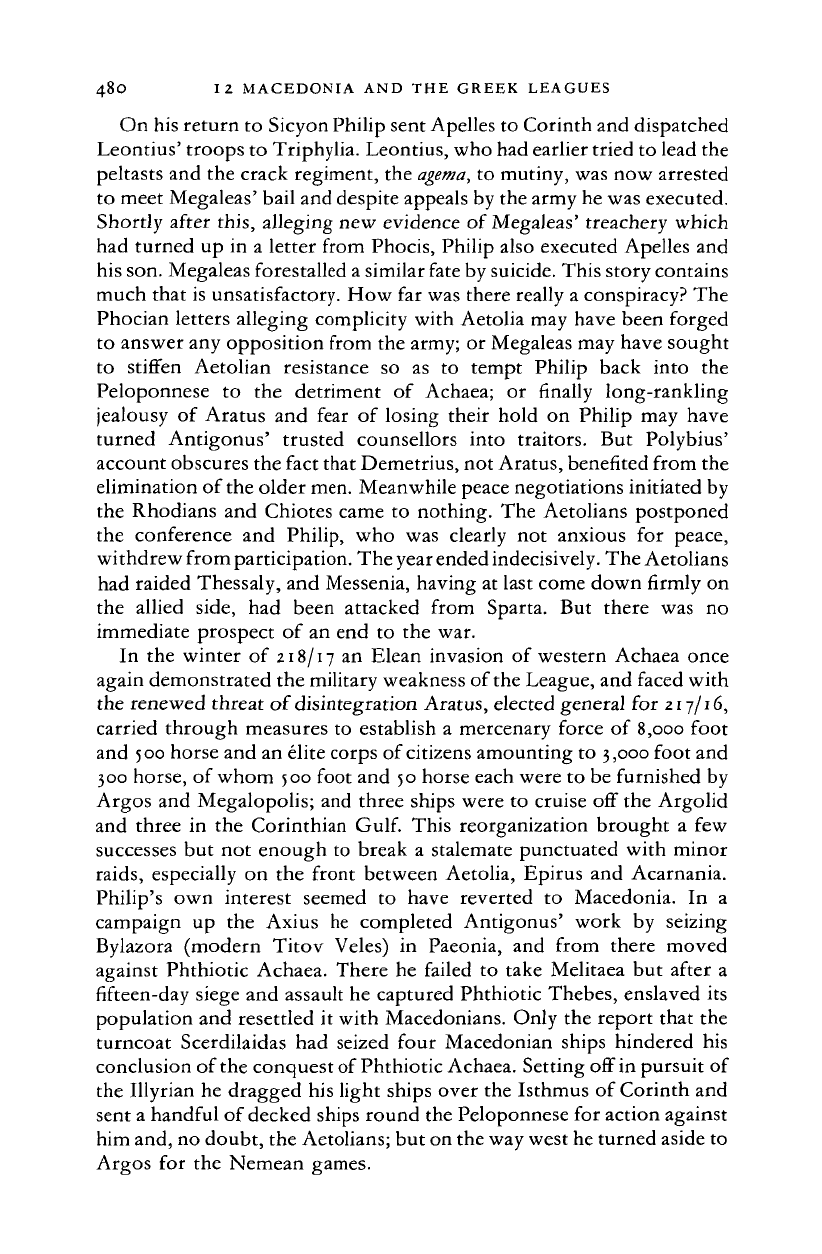
480 12 MACEDONIA AND THE GREEK LEAGUES
On his return to Sicyon Philip sent Apelles to Corinth and dispatched
Leontius' troops to Triphylia. Leontius, who had earlier tried to lead the
peltasts and the crack regiment, the
agema,
to mutiny, was now arrested
to meet Megaleas' bail and despite appeals by the army he was executed.
Shortly after this, alleging new evidence of Megaleas' treachery which
had turned up in a letter from Phocis, Philip also executed Apelles and
his son. Megaleas forestalled a similar fate by suicide. This story contains
much that is unsatisfactory. How far was there really a conspiracy? The
Phocian letters alleging complicity with Aetolia may have been forged
to answer any opposition from the army; or Megaleas may have sought
to stiffen Aetolian resistance
so as to
tempt Philip back into
the
Peloponnese
to the
detriment
of
Achaea;
or
finally long-rankling
jealousy
of
Aratus and fear
of
losing their hold on Philip may have
turned Antigonus' trusted counsellors into traitors.
But
Polybius'
account obscures the fact that Demetrius, not Aratus, benefited from the
elimination of the older men. Meanwhile peace negotiations initiated by
the Rhodians and Chiotes came to nothing. The Aetolians postponed
the conference and Philip, who was clearly not anxious
for
peace,
withdrew from participation. The year ended indecisively. The Aetolians
had raided Thessaly, and Messenia, having at last come down firmly on
the allied side,
had
been attacked from Sparta. But there was
no
immediate prospect of an end to the war.
In the winter
of
218/17 an Elean invasion of western Achaea once
again demonstrated the military weakness of
the
League, and faced with
the renewed threat of disintegration Aratus, elected general for 217/16,
carried through measures to establish a mercenary force
of
8,000
foot
and 500 horse and an elite corps of citizens amounting to 3,000 foot and
300 horse, of whom 500 foot and 50 horse each were to be furnished by
Argos and Megalopolis; and three ships were to cruise off the Argolid
and three
in
the Corinthian
Gulf.
This reorganization brought
a
few
successes but not enough to break
a
stalemate punctuated with minor
raids,
especially on the front between Aetolia, Epirus and Acarnania.
Philip's own interest seemed
to
have reverted
to
Macedonia.
In a
campaign
up
the Axius
he
completed Antigonus' work
by
seizing
Bylazora (modern Titov Veles)
in
Paeonia, and from there moved
against Phthiotic Achaea. There he failed to take Melitaea but after
a
fifteen-day siege and assault he captured Phthiotic Thebes, enslaved its
population and resettled it with Macedonians. Only the report that the
turncoat Scerdilaidas had seized four Macedonian ships hindered his
conclusion of the conquest of Phthiotic Achaea. Setting off
in
pursuit of
the Illyrian he dragged his light ships over the Isthmus of Corinth and
sent a handful of decked ships round the Peloponnese for action against
him and, no doubt, the Aetolians; but on the way west he turned aside to
Argos for the Nemean games.
Cambridge Histories Online © Cambridge University Press, 2008
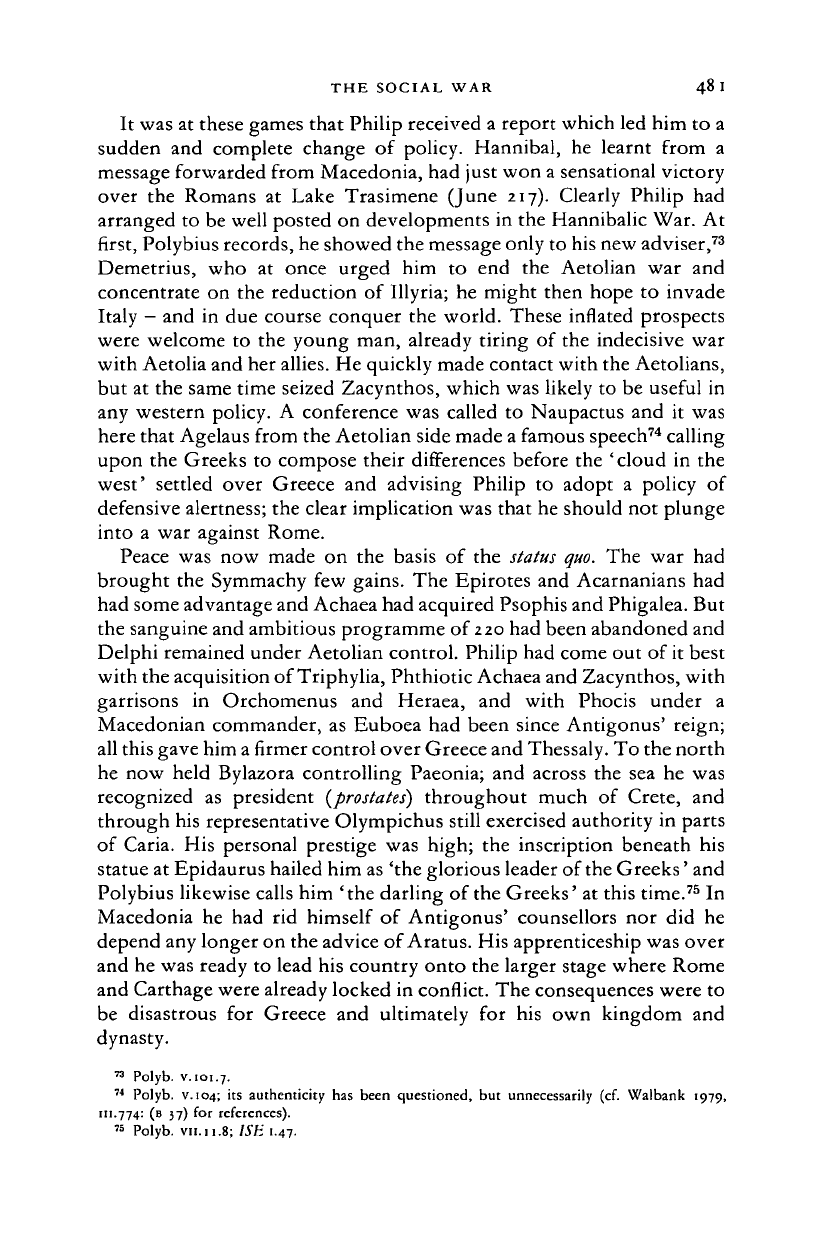
THE
SOCIAL
WAR 48 I
It was at these games that Philip received a report which led him to a
sudden and complete change of policy. Hannibal, he learnt from a
message forwarded from Macedonia, had just won a sensational victory
over the Romans at Lake Trasimene (June 217). Clearly Philip had
arranged to be well posted on developments in the Hannibalic War. At
first, Polybius records, he showed the message only to his new adviser,
73
Demetrius, who at once urged him to end the Aetolian war and
concentrate on the reduction of Ulyria; he might then hope to invade
Italy
—
and in due course conquer the world. These inflated prospects
were welcome to the young man, already tiring of the indecisive war
with Aetolia and her allies. He quickly made contact with the Aetolians,
but at the same time seized Zacynthos, which was likely to be useful in
any western policy. A conference was called to Naupactus and it was
here that Agelaus from the Aetolian side made a famous speech
74
calling
upon the Greeks to compose their differences before the 'cloud in the
west' settled over Greece and advising Philip to adopt a policy of
defensive alertness; the clear implication was that he should not plunge
into a war against Rome.
Peace was now made on the basis of the status
quo.
The war had
brought the Symmachy few gains. The Epirotes and Acarnanians had
had some advantage and Achaea had acquired Psophis and Phigalea. But
the sanguine and ambitious programme of
220
had been abandoned and
Delphi remained under Aetolian control. Philip had come out of it best
with the acquisition of Triphylia, Phthiotic Achaea and Zacynthos, with
garrisons in Orchomenus and Heraea, and with Phocis under a
Macedonian commander, as Euboea had been since Antigonus' reign;
all this gave him a
firmer
control over Greece and Thessaly. To the north
he now held Bylazora controlling Paeonia; and across the sea he was
recognized as president
{prostates)
throughout much of Crete, and
through his representative Olympichus still exercised authority in parts
of Caria. His personal prestige was high; the inscription beneath his
statue at Epidaurus hailed him as 'the glorious leader of
the
Greeks' and
Polybius likewise calls him 'the darling of the Greeks' at this time.
75
In
Macedonia he had rid himself of Antigonus' counsellors nor did he
depend any longer on the advice of Aratus. His apprenticeship was over
and he was ready to lead his country onto the larger stage where Rome
and Carthage were already locked in conflict. The consequences were to
be disastrous for Greece and ultimately for his own kingdom and
dynasty.
73
Polyb. v. 101.7.
71
Polyb. v.
104;
its authenticity has been questioned, but unnecessarily (cf. Walbank 1979,
in.774:
(B 37) for references).
75
Polyb. vii.11.8; 1SH 1.47.
Cambridge Histories Online © Cambridge University Press, 2008

HELLENISTIC DYNASTIES
I. THE
PTOLEMIES
Ptolemy
I
Soter 305-283
Ptolemy
II
Philadelphia 283-246
Ptolemy
III
Euergetes
I
246-221
Ptolemy
IV
Philopator 221-204
Ptolemy
V
Epiphanes 204—180
Ptolemy
VI
Philometor 180-145
with Ptolemy VIII Euergetes
II
and
Cleopatra
II
170—164
with Cleopatra
II
163—145
Ptolemy VIII Euergetes
II
(restored) 145-116
Cleopatra
III and
Ptolemy
IX
Soter
II
(Lathyrus) 116—107
Cleopatra
III and
Ptolemy
X
Alexander
I
107-101
Ptolemy
X
Alexander
I
and
Cleopatra
Berenice 101-88
Ptolemy
IX
Soter
II
(restored)
88-81
Cleopatra Berenice
and
Ptolemy
XI
Alexander
II 80
Ptolemy
XII
Neos Dionysus (Auletes) 80-58
Berenice
IV
(at
first with Cleopatra
Tryphaena) 58-56
Berenice
IV
and
Archelaus 56-55
Ptolemy
XII
Neos Dionysus (restored)
5
5—51
Cleopatra
VII
Philopator 51—30
2.
THE
SELEUCIDS
Seleucus
I
Nicator
Antiochus
I
Soter
Antiochus
II
Theos
Seleucus
II
Callinicus
Seleucus
III
Soter
Antiochus
III
Megas
Seleucus
IV
Philopator
Antiochus
IV
Epiphanes
Antiochus
V
Eupator
Demetrius
I
Soter
Alexander Balas
Demetrius
II
Nicator
Antiochus
VI
Epiphanes
Antiochus
VII
(Sidetes)
Demetrius
II
Nicator (restored)
Cleopatra Thea
305—281
281-261
261—246
246—226/5
226/5-223
223-187
187-175
175-164
164—162
162—150
150-145
145-140
145-142/1
or 139/8
138-129
129-126/5
126/5-123
482
Cambridge Histories Online © Cambridge University Press, 2008
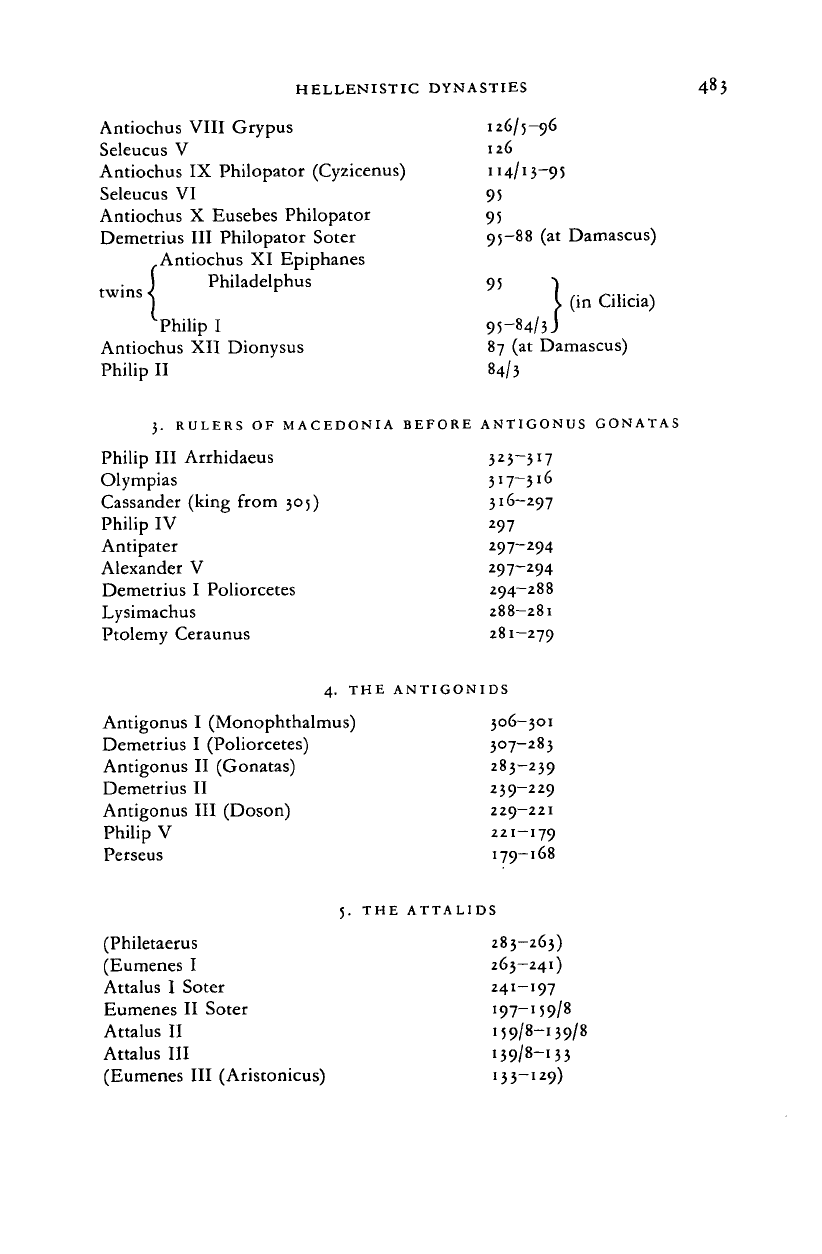
HELLENISTIC DYNASTIES
4
8
3
Antiochus VIII Grypus
Seleucus
V
Antiochus
IX
Philopator (Cyzicenus)
Seleucus
VI
Antiochus
X
Eusebes Philopator
Demetrius
III
Philopator Soter
Antiochus
XI
Epiphanes
.
[
Philadelphus
LWllla
S.
Philip
I
Antiochus
XII
Dionysus
Philip
II
3.
RULERS OF MACEDONIA BEFORE
Philip
III
Arrhidaeus
Olympias
Cassander (king from
305)
Philip
IV
Antipater
Alexander
V
Demetrius
I
Poliorcetes
Lysimachus
Ptolemy Ceraunus
126/5-96
126
1i4/i3-95
95
95
95-88
(at
Damascus)
95
)
\
(in
Cilicia)
95-84/3J
87
(at
Damascus)
84/3
ANTIGONUS GONAT
323-317
317-316
316-297
297
297-294
2
97~
2
94
294-288
288-281
281-279
4.
THE
ANTIGONIDS
Antigonus
I
(Monophthalmus) 306-301
Demetrius
I
(Poliorcetes) 307-283
Antigonus
II
(Gonatas) 283-239
Demetrius
II
239-229
Antigonus
III
(Doson) 229-221
Philip
V
221-179
Perseus 179-168
5.
THE
ATTALIDS
(Philetaerus 283-263)
(Eumenes
I
263-241)
Attalus
I
Soter 241-197
Eumenes
II
Soter 197-159/8
Attalus
II
159/8-139/8
Attalus
III
139/8-133
(Eumenes
III
(Aristonicus) 133-129)
Cambridge Histories Online © Cambridge University Press, 2008
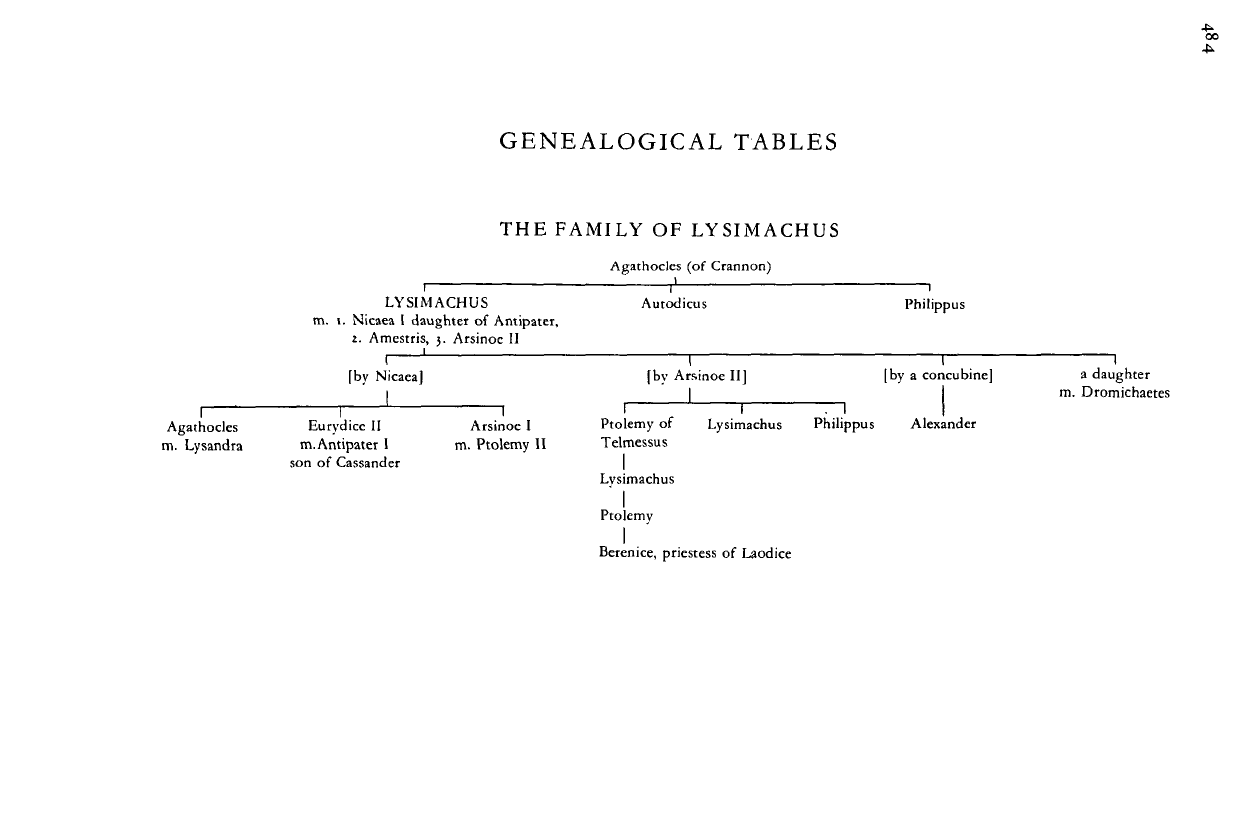
GENEALOGICAL TABLES
THE FAMILY OF LYSIMACHUS
Agathocles (of Crannon)
^__
i
LYSIMACHUS Autodicus Philippus
m. i. Nicaea I daughter of Antipater,
2.
Amestris, 3. Arsinoe II
I I I 1
[by Nicaea] [by Arsinoe II] [by a concubine] a daughter
J , L
i 1 — i i i n
Agathocles Eurydice II Arsinoe I Ptolemy of Lysimachus Philippus Alexander
m. Lysandra m.Antipater I m. Ptolemy II Telmessus
son of Cassander |
Lysimachus
' I
Ptolemy
I
Berenice, priestess of Laodice
m. Dromichaetes
Cambridge Histories Online © Cambridge University Press, 2008
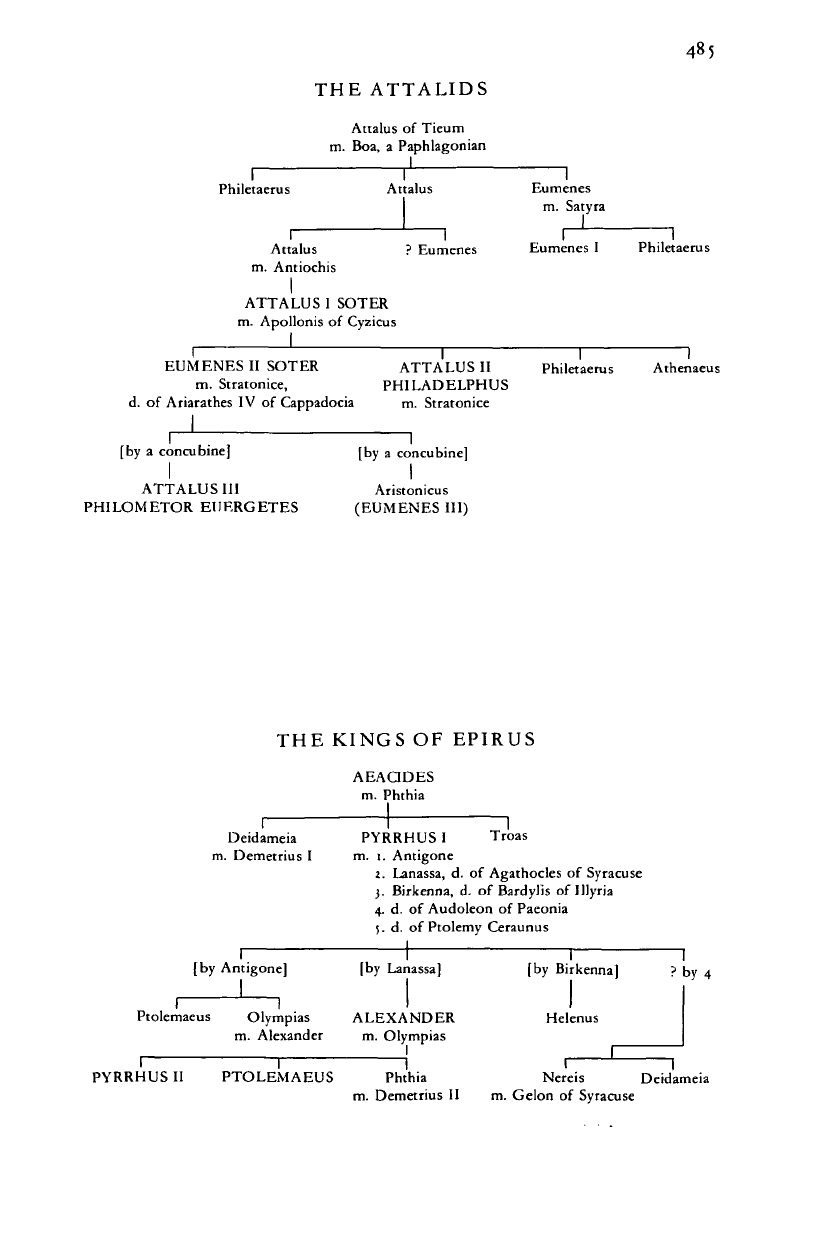
THE ATTALIDS
Attalus of Tieum
m. Boa, a Paphlagonian
i
H 1
Philetaerus Attalus Eumenes
m. Satyra
I
I I I
Attalus ? Eumenes Eumenes I Philetaerus
m. Antiochis
I
ATTALUSISOTER
m. Apollonis of Cyzicus
, |
I
I I I
EUMENES II SOTER ATTALUS II Philetaerus Athenaeus
m. Stratonice, PH1LADELPHUS
d. of Ariarathes IV of Cappadocia m. Stratonice
I
I
[by a concubine] [by a concubine]
I
I
ATTALUS III Aristonicus
PHILOMETOR EUERGETES (EUMENES III)
THE KINGS OF EPIRUS
AEACIDES
m. Phthia
Deidameia PYRRHUS I Troas
m. Demetrius I m. l. Antigone
a. Lanassa, d. of Agathocles of Syracuse
3.
Birkcnna, d. of Bardylis of Illyria
4.
d. of Audoleon of Paeonia
5.
d. of Ptolemy Ceraunus
1
I i I
[by Antigone] [by Lanassa] [by Birkenna] ? by 4
I
I
Ptolemaeus Olympias ALEXANDER Helenus
m. Alexander m. Olympias
I I i I I
PYRRHUS II PTOLEMAEUS Phthia Nereis Deidameia
m. Demetrius II m. Gelon of Syracuse
Cambridge Histories Online © Cambridge University Press, 2008
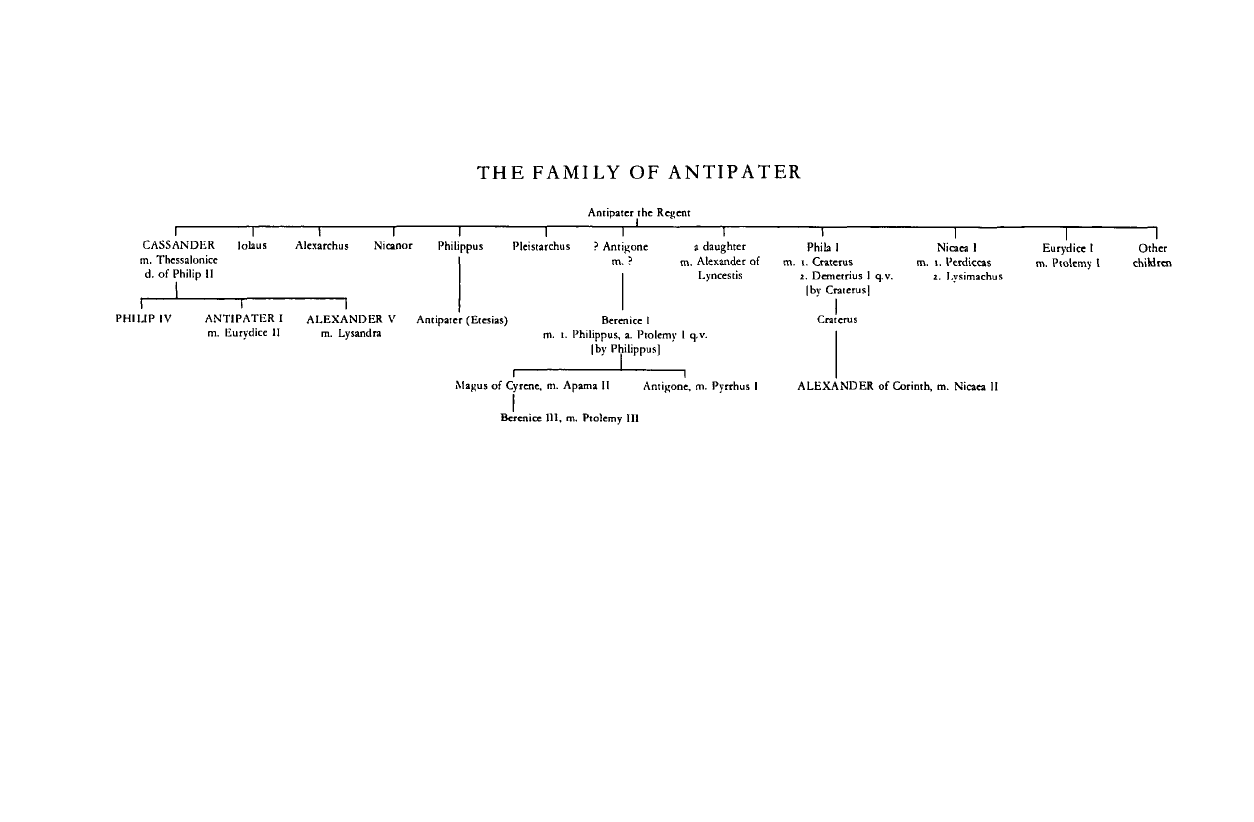
THE FAMILY OF ANTIPATER
00
ON
Antipatcr the Regent
i
1 1 1 i 1 r
CASSANDER lolaus Alcxarchus Nicanor Philippus Pleistarchus ? Antigone a daughter
—i—
Phila I
1
m. Thcssalonice
d. of Philip II
i r i
PHILIP IV ANTIPATER I ALEXANDER V Antipatcr (Eiesias) Berenice I
m. Eurydicc II m. Lysandra m. I. Philippus, a. Ptolemy I q.v.
|
by
Philippus]
Nicaca
1
Eurydicc
1
Other
,. Alexander of m. i. Cratcrus m. i. Perdiccas m. Ptolemy I children
Lyncestis i. Demetrius I q.v.
|by Craterusj
I
2.
J.ysimachus
Cratcrus
Magus of Cyrene, m. Apama II Antigone, m. Pyrrhus I ALEXANDER of Corinth, m. Nicaea II
I
Berenice III, m. Ptolemy III
Cambridge Histories Online © Cambridge University Press, 2008
